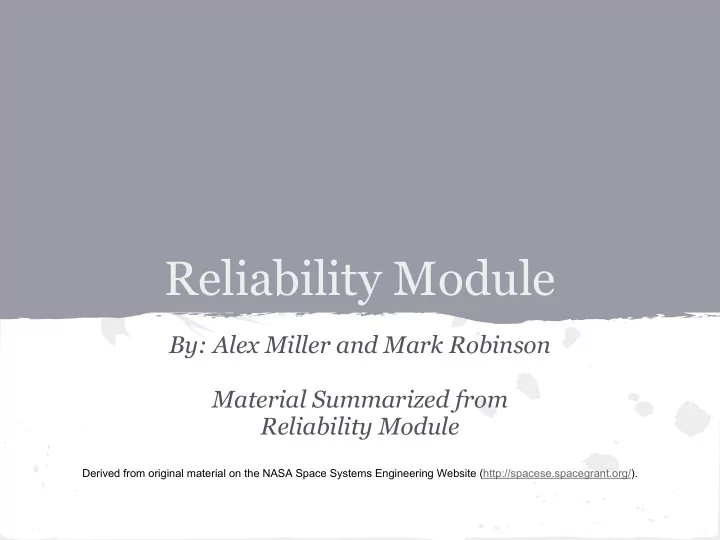

Reliability Module By: Alex Miller and Mark Robinson Material Summarized from Reliability Module Derived from original material on the NASA Space Systems Engineering Website (http://spacese.spacegrant.org/).
Key Concepts ● Understanding the importance of reliability as an engineering discipline ● Definitions and uses for important engineering concepts ○ Constant failure rate, MTBF, 'bathtub' curve, etc. ● The meaning and practice of redundancy (fault tolerance, functional redundancy, fault avoidance) ● Ways to calculate reliability ○ Mathematically ○ Visually (block diagrams) Source: Exploration Systems Engineering Version 1.0, Reliability Module
Definition of Reliability 1 ● Reliability: "The probability that the system-of-interest will not fail for a given period of time under specified operating conditions." ○ Reliability is an inherent system design characteristic ○ Reliability plays a key role in determining the system's cost effectiveness NASA's Systems Engineering Handbook definition (1995 edition) Source: Exploration Systems Engineering Version 1.0, Reliability Module
Definition of Reliability 2 ● Reliability Engineering: "Specialty discipline within the systems engineering process." ○ Design - including design features that ensure the system can perform in the predicted physical environment throughout the mission. ○ Trade studies - reliability as a figure of merit. Often traded with cost. ○ Modeling - reliability prediction models, reflecting environmental considerations and applicable experience from previous projects. ○ Test - making independent predictions of system reliability for test planning/program; sets environmental test requirements and specifications for hardware qualification. NASA's Systems Engineering Handbook definition (1995 edition)
Constant Failure Rate Probability Distribution is usually described as an exponential function: R=e t/M R = reliability t = time M = Mean time between failures For systems that must operate continuously, it is common to express their reliability in terms of the Mean Time Between Failure (MTBF) Source: Exploration Systems Engineering Version 1.0, Reliability Module
"Bathtub" Failure Rate Curve Three phases: 1. Burn in period - higher failure rate due to infant mortality 2. Useful life period - low failure rate due to random events 3. Old age - increase failure rate due to parts wearing out Source: Exploration Systems Engineering Version 1.0, Reliability Module
"Bathtub" Failure Rate Curve
Redundancy ● Redundancy: "Exceeding what is necessary...characterized by or containing an excess." ( source: Merriam-Webster Dictionary) ● Two key ideas for systems engineering: ○ Fault Tolerance - The ability of a system to continue operating after a component failure has occurred ■ Implemented through the use of redundant systems ○ Functional Redundancy - Design is robust enough to respond to component failures through work- arounds and the use of systems in ways that they weren't originally intended for ■ Examples: Apollo 13, MER, NEAR Shoemaker Source: Exploration Systems Engineering Version 1.0, Reliability Module
Fault Avoidance ● Ways to achieve reliability in space: ○ Generous environmental and design margins ○ Use of high-quality design components ■ Class S (space qualified) ■ Commercial-Off-The-Shelf ● Must be careful that OTS parts work in intended environment ○ Highly controlled manufacturing, assembly, and documentation ○ Acceptance testing or inspections on all parts if possible Source: Exploration Systems Engineering Version 1.0, Reliability Module
Example Calculations Source: Exploration Systems Engineering Version 1.0, Reliability Module
Example Calculations Both need to work Series: A x B = Component 1 Total Reliability Component 2 Reliability: 0.90 (0.9) x (0.9) = Reliability: 0.90 Input 0.81 reliability Component 1 Reliability: 0.90 Parallel: (A + B) - (A x B) = Total Reliability Only one (0.9 + 0.9) - (0.9 x 0.9) = Input needs to work Component 2 (1.80 - 0.81) = Reliability: 0.90 0.99 reliability
Tie-In to Rover project ● All subsystem groups have selected components based on reliability (OTS, heritage, etc.) ○ Fault avoidance ● When practical, redundancy has been added to all key mission components ○ We have created designs, made trade-studies, put together models, and intend to lab test components ● We strive to make the rover 'smart' so that it can enter safe-mode or question the commands from ground when threatened ○ Increases reliability by decreasing the chance for critical mistakes Source: Exploration Systems Engineering Version 1.0, Reliability Module
Summary -Reliability is a key attribute of space systems, influencing systems engineering activities such as design, trade studies, modeling, and test. -The reliability function, R(t), is determined from the probability that a system will be successful for at least some specified time. -The Bathtub curve expresses the failure rate as it depends on the age of the system. Early and late in life of the system (similar to the human body) significantly higher failure rates occur called “infant mortality” and “old age” regions. Between these regions normally lies an extended period of approximately constant failure rate. The reliability of systems operating in this region can be simply characterized by an exponential function. -Ways to achieve reliability include fault tolerance, functional redundancy and fault avoidance. -Block diagrams and event trees are useful tools in calculating reliability. An understanding of probability basics is required. Source: Exploration Systems Engineering Version 1.0, Reliability Module
Recommend
More recommend